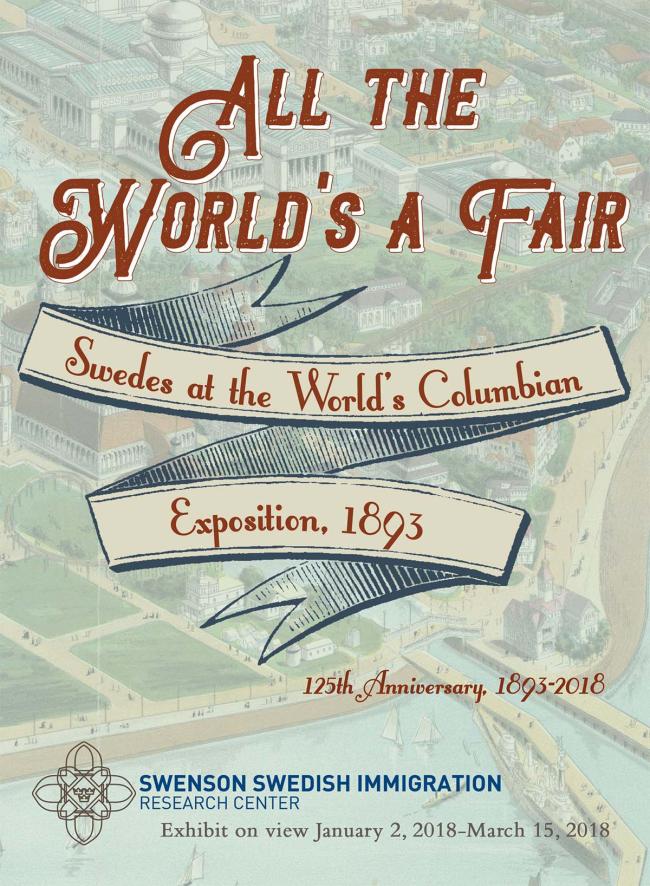
Exhibit shows Swedes' role at 1893 World's Fair

The Swenson Swedish Immigration Research Center is presenting "All the World’s a Fair: Swedes at the World’s Columbian Exposition" through March 15.
The center is located in the Denkmann Memorial Building, first floor. Hours are 9 a.m.-noon and 1-4:30 p.m. weekdays
The exhibit takes a look at Swedes at the World’s Columbian Exposition, 1893, on the occasion of the 125th anniversary of the fair. It includes photos, maps, guides and souvenir memorabilia.
The Columbian Exposition took place in Chicago, celebrating the 400th anniversary of Christopher Columbus’s arrival in North America in 1492. Nearly 200 buildings filled Jackson Park and featured displays on manufacturing, transportation, horticulture, and the arts, along with national pavilions of 19 countries.
The "White City," so named for the number of white-façade buildings at the fairgrounds, was home to this six-month progress and industry expo.
Sweden and Norway had separate pavilions at the Exposition. In addition, Sweden was represented in the Manufacturing, Agricultural and Dairy departments, Women’s building, and in Fine Arts. The Fine Arts exhibits included works by Anders Zorn, Carl Larsson, and Prince Eugene. Norway also contributed a Viking ship, which sailed across the Atlantic and was displayed in Chicago from the time of the fair until moving to Good Templar Park in Geneva, Ill., in 1994.
Sweden's building was made of wood and modeled after the old Swedish Cathedral style. It was constructed in Sweden, dismantled, and shipped to Chicago in sections. The building covered 12,000 square feet and had a 200-foot tall tower. The exhibits inside represented the last century of Swedish history and culture. They included furniture, national costumes, artifacts from the Nordiska Museet, and a tourism display. They were designed to represent rustic country homes, Sweden’s beautiful landscape, and "illustrate Sweden’s school system."
Swedes take over
On July 20, 1893, the Swedes dominated Jackson Park. More than 12,500 Swedes participated in a parade, concerts, and speeches with nearly double the number of spectators.
While the delegation from Sweden presided over the Sweden Day festivities, it was a distinctly Swedish-American event. The parade, organized entirely by Swedish-Americans, consisted of five parade marshals, all of whom were elite Swedish-Americans. Included was Robert Lindblom, a well-known trader on the Chicago Board of Trade. More than 50 Swedish and Swedish-American groups marched in the parade.
There was debate concerning the festivities between the secular and religious Swedish-American groups, but in the end national unity prevailed. Religious Swedes may have formally stayed out of the event, but they were among the individuals marching and attending the days’ events. Praise for the parade was written in secular and religious Swedish-American press alike; "never before have the Swedes so united and so completely gathered around the blue and yellow flag."
The American Union of Swedish Singers, an umbrella group for Swedish-American singing societies, was founded in 1892. It held its first singing festival in Chicago, giving three concerts at the World’s Fair. The Festival Hall filled all its 6,500 seats each performance. American press praised the concerts, but even more important was the approval of the German-American singing groups, exemplars of singing groups at that time.
Sweden’s Day festivities concluded with evening speeches given under the trees near Sweden’s pavilion. Mr. Leffler, Royal Swedish Commissioner, gave a rousing speech thanking the American people for being friends to the Swedes, which was met with four hearty cheers. Commissioner Thomas B. Bryan and Professor John Enander also spoke. Enander underscored the importance of Sweden’s people to its success as a European power. Bryan praised the impact of Swedish immigrants on America, saying they were "pioneers of civilization" and that no other immigrant groups "surpassed them in industriously... opening up our continent" or "excelled them in loyalty to the Union."
The celebration of Swedishness at the Columbian World’s Fair demonstrated to the American audience that the Chicago Swedes were ready to enter a public arena. Swedes in America wanted greater influence socially and politically. Their presentation during the World’s Fair showed that they could come out and exert their influence. Indeed, in the late 1890s, Swedish Americans began obtaining positions of political influence in Chicago. Swedish-Americans were demonstrating that they were willing and able serve their adopted home country.
Contact:
Lisa Huntsha, 309-794-7496
